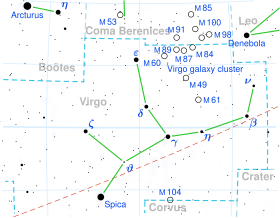| Observation data Epoch J2000 Equinox J2000 | |
|---|---|
| Constellation | Virgo |
| Right ascension | 13h 34m 41.591s[1] |
| Declination | –00° 35′ 44.95″[1] |
| Apparent magnitude (V) | +3.376[2] |
| Characteristics | |
| Spectral type | A3 V[3] |
| U−B color index | +0.141[2] |
| B−V color index | +0.114[2] |
| Astrometry | |
| Radial velocity (Rv) | –13.2[2] km/s |
| Proper motion (μ) | RA: –280.48 ± 0.17[1] mas/yr Dec.: +49.05 ± 0.12[1] mas/yr |
| Parallax (π) | 44.03 ± 0.19 mas[1] |
| Distance | 74.1 ± 0.3 ly (22.71 ± 0.10 pc) |
| Absolute magnitude (MV) | 1.64±0.05[4] |
| Details | |
| ζ Vir A | |
| Mass | 2.041±0.024[4] M☉ |
| Radius | 2.079±0.025[5] R☉ |
| Luminosity | 17.885±0.252[5] L☉ |
| Surface gravity (log g) | 4.12 cgs |
| Temperature | 8247±52[5] K |
| Rotational velocity (v sin i) | 222[6] km/s |
| Age | 0.51[7] Gyr |
| ζ Vir B | |
| Mass | 0.168+0.012 −0.016[4] M☉ |
| Other designations | |
| Database references | |
| SIMBAD | data |
Zeta Virginis (ζ Virginis, abbreviated Zeta Vir, ζ Vir) is a binary star in the zodiac constellation of Virgo. It is visible to the naked eye with an apparent visual magnitude of +3.376 and is located about a half degree south of the celestial equator. Based on parallax measurements obtained during the Hipparcos mission, it is about 74 light-years (23 parsecs) distant from the Sun.
The two components are designated Zeta Virginis A (officially named Heze /ˈhiːziː/, a mid-20th-century name for the system)[8][9] and B.
- ^ a b c d e Cite error: The named reference
van Leeuwen2007was invoked but never defined (see the help page). - ^ a b c d Cite error: The named reference
Hip_Hezewas invoked but never defined (see the help page). - ^ Cite error: The named reference
Alcyonewas invoked but never defined (see the help page). - ^ a b c Cite error: The named reference
apj712_1_421was invoked but never defined (see the help page). - ^ a b c Cite error: The named reference
kalerACwas invoked but never defined (see the help page). - ^ Cite error: The named reference
aaa463_2_671was invoked but never defined (see the help page). - ^ Cite error: The named reference
apj653_1_675was invoked but never defined (see the help page). - ^ Kunitzsch, Paul; Smart, Tim (2006). A Dictionary of Modern star Names: A Short Guide to 254 Star Names and Their Derivations (2nd rev. ed.). Cambridge, Massachusetts: Sky Pub. ISBN 978-1-931559-44-7.
- ^ "Naming Stars". IAU.org. Retrieved 18 June 2018.
